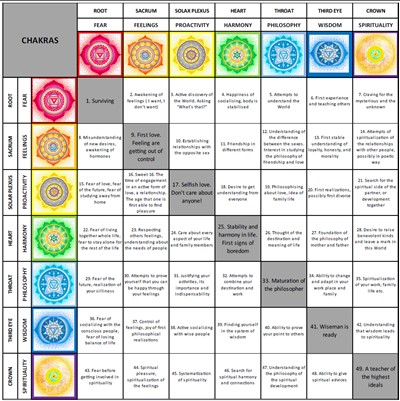You have probably heard about the 7 year itch. And also the nice story about our body renewing ALL its cells every 7 years. Maybe you’ve also heard about the 7-year Chakras from Vedic India, or about 7 year cycles from the ancient Greeks, or the Waldorf theories of the anthroposophist Rudolf Steiner. And maybe you are wondering, “Is there any truth behind these 7-year cycles?” or “Do these 7-year cycles still apply to our lives today?”.
Read further to understand why these are outdated and how Life, portioned in Blobs of 6-years and bundled in the seasons of Spring (growing), Summer (maturing), Autumn (harvesting) and Winter (releasing) mirror our lives, as we live it today, in a much more adequate manner.
Does our body renew itself every 7 years?
To start with, let’s get rid of this one, absolutely false, belief that the body and mind renew themselves every 7 years. Sure, cells in our bodies die all the time. And they are renewed continuously. But, according to The New York Public Library’s Science Desk Reference (Stonesong Press, 1995) red blood cells replace themselves every four months; white blood cells do so every 2-3 weeks. Colon cells last only 4 days and sperm cells only 3! Skin cells live 2-3 weeks and brain cells last for life! Neurons in our brains do die, but they are never replaced. Sure, we do go through many changes in 7 years, but so do we every 5 years or 10 years or even 2 years. Scientifically, there really is no basis behind the 7 year belief.
Is the 7 year itch true?
 A movie starring Marilyn Monroe from 1955 with the name “The Seven Year Itch” helped popularize the idea about marriages getting in to trouble every 7 years. 7 years after marriage often is a difficult time that corresponds with couples having less time for each other, as they run around their little kids at home. But data actually shows that 7 years just represents an average. A study conducted by a psychology professor from Wright State University, Dr. Larry A. Kurdek, suggests that there tends to be a decline in marital quality after 4 years, with a high number of divorces actually happening at that time. Another study conducted by the Grant Thornton accountancy group in 2010 shows that most marriages actually fall apart at the 12 year mark. Another study from 2012 actually shows the dip to be around 3 years after marriage, citing the reason to be that the today’s couples often get together later in life, without having spent enough time getting to know each other before having children. So, once again here, there is no real scientific proof or data pointing towards a recurring 7 year itch.
A movie starring Marilyn Monroe from 1955 with the name “The Seven Year Itch” helped popularize the idea about marriages getting in to trouble every 7 years. 7 years after marriage often is a difficult time that corresponds with couples having less time for each other, as they run around their little kids at home. But data actually shows that 7 years just represents an average. A study conducted by a psychology professor from Wright State University, Dr. Larry A. Kurdek, suggests that there tends to be a decline in marital quality after 4 years, with a high number of divorces actually happening at that time. Another study conducted by the Grant Thornton accountancy group in 2010 shows that most marriages actually fall apart at the 12 year mark. Another study from 2012 actually shows the dip to be around 3 years after marriage, citing the reason to be that the today’s couples often get together later in life, without having spent enough time getting to know each other before having children. So, once again here, there is no real scientific proof or data pointing towards a recurring 7 year itch.
Are 7 year life cycles keeping up with our changing lifestyles?
Rudolf Steiner, a teacher of Anthroposophy, based on whose theories the Waldorf school concept was developed, described the cycle of life in stages of 7 years in 1924. Several 7-year life cycle models today are based on his stages. Since then human life has made many advancements, and thanks to medical advances, many more years have been added to the human life span. Read below to see how the 7 year life stages tend to miss out important milestones that are prominently visible in the 6 year life stage descriptions.
Rudolf Steiner’s first 3 stages (0-7; 7-14; 14-21 years) cover the childhood and learning years. Unfortunately, important milestones that exist today are not highlighted appropriately in these stages as opposed to the Spring season of the 6 year Blobs (1-24 years) :
- Steiner’s 0-7 years vs. the 1st Blob of 1-6 years: Schooling in most OECD countries starts at 6 (if not already at 5), thus completing the toddler years at around 6.
- Steiner’s 14-21 vs. the 3rd Blob of 13-18 years: Today puberty and teenage years are considered to be the 13-18/19 age group, with a majority of teens finishing high school at around 18 years of age.
- With education taking longer and longer, the learning years do not end with 21 any more. Most vocations and academic studies go well in to the mid-20s, as described in the 4th Blob of Spring: The Emerging Adult (19-24 years).
The next 3 Steiner “Sun” stages (21-28; 28-35; 35-42) signify the adult working years where play is turned in to responsibility. In contrast, the Summer Season of the 6-year Blobs spans the years 25- 48, reflecting the shift in the highly productive working years of today.
- Steiner’s 21-28 vs. the 4th and 5th Blobs of 19-24 & 25-30 years: Steiner’s “Sun” stages fail to capture the new trend of the Emerging Adults (19-24 years). In this age group, the emerging adults do not see themselves as adolescents any more, but many also do not see themselves entirely as adults who should take on full financial responsibility and commit to long term relationships. These adulthood responsibilities are increasingly being postponed to later, as described in the 1st Blob of Summer: Young Adult (25-30 years).
The last 3 stages (42-48; 48-56; 56-63) are the last stages as described by Rudolf Steiner, where Saturn completes its second return and the soul can manifest an even higher element of Self called Spirit Man.
- With human lifespan now increasingly extending in to the 80s and 90s the Autumn Season (49-72 years) of the 6 year Blobs describes today’s middle-aged adults as healthy, productive, independence seeking adults as compared to the ‘soul-seeking’ adults of the Saturn stages.
- The traditional age of retirement, that typically ends with the 3rd Blob of Summer: The Young Elder (61-66 years), and is portrayed in Steiner’s Stages, is now being considered to be postponed by some OECD countries. This inevitable change, resulting from our ever longer lives and portrayed very well in the book The 100 year life – living and working in an age of longevity, makes it a financial necessity to extend active working life to the early 70s (4th Blob of Autumn: The Independent Elder: 67-72 years), instead of the relatively “young” age of 63 (where Saturn has already completed its second return).
The 7 cycles of the 7 Chakras
As explained illustratively in the article “The 7 cycles of the 7 chakra – The continuity of life” the Indian Vedic Chakra is based on the philosophy that:
…every seven years humans achieve various levels of understanding based upon what phase of spiritual development their endocrine/ chakra systems is in…Each of the chakras affect our life in various ways. Within each of these stages, the other chakras influence the progress of the individual’s self-realization process. There are in each cycle primary influential traits that direct these phases. Every seven years we repeat this cycle, while during that phase feeling the impact of the chakra that is maturing in that particular cycle.

The 7×7 matrix defines the life cycle, year by year, and ends at 49 years. At a time when the average life of humans was around 50 years, or maybe even 60, these descriptions may have sufficed. But with today’s human lifespan extending in to the 80s and 90s, we simply have much more time to achieve all that is compressed in this 49-year lifespan. For example, according to the Chakras, in the 3rd Chakra (15-21 years), the individual is seeking stable relationships. Today’s 21 or even 24 year olds (Emerging Adults) (or sometimes even 30 year olds!) are seldom ready for such commitments. The seventh and last Chakra (43-49 years) in this cycle is the cycle of spirituality. In today’s world, this soul seeking maturity is also being postponed to later stages.
I believe the time has come to redefine these age-old definitions and adapt them to today’s lifestyles. The 6-year Blobs describe this change in the most natural manner. What do you think? Would be great to hear your views on this!
Read more about the 6 year Blobs:
Spring: 1-6, 7-12, 13-18, 19-24
Summer: 25-30, 31-36, 37-42, 43-48
Autumn: 49-54, 55-60, 61-66, 67-72
Winter: 73-78, 79-84, 85-91, 91-…
References and Resources
Does the Human Body Really Replace Itself Every 7 Years?
Study Finds a 7-Year Itch, and a 4-Year One
Forget the seven-year itch, the real test comes at TWELVE years
The Greek Concept of the “Seven Stages of Life”and Its New Testament Significance
The Stages of Life According to Rudolf Steiner



It may just be me, but it seems like my life has happened in 5 year cycles. I wonder if we don’t all have different cycles, depending on our life circumstances and personality?
LikeLike
That’s really interesting. I don’t think you are alone, because I also have a friend who keeps track of his life in a life-calendar divided up in 5 years. He writes all major milestones of that 5-year period in each box. He is now 50 and enjoys looking at his calendar every now and then. Everyone is different and I can imagine major milestones happening at 5 year intervals too e.g. start schooling at 5, puberty breaks in at 10, finish basic schooling at 15, finish vocational studies and start working at 20, maybe first kid at 25,….This example of course being a little fast-forwarded :). Would be interesting to hear your version!
LikeLiked by 1 person
Hmm… I think it’s not so much the life events I did predict, but the life events I couldn’t predict; i.e. moving, job changes, illnesses/deaths, relationship changes, etc. Those for me overpowered the typical changes. Of course it’s not exact; I would characterize 14-20 as one cycle, for instance.
LikeLiked by 1 person
Great article, which challenges and corrects old held belief systems. Well written and interesting and relevant info!
Thanks!
LikeLike
Thank so for liking, Shaleza. Glad you liked it! Any thoughts about the 6 year blobs?
LikeLike
This was really interesting!
LikeLike
Interesting post. I know in the Bible the number 7 represents completeness. It is used 735 times in Scripture! I wonder if there’s a connection. Today I published the next chapter of my cancer journey after a break.
LikeLiked by 1 person
1,3,8 and 9 are also such special numbers. The only connection I heard 6 with is with the passage of time (12 months in a year, 12 hours in a day,….)
LikeLiked by 1 person